TSA Weekly: Feb. 16 - 20, 2009


The 2008 Federal Human Capital Survey shows an improving trend since 2004, with TSA employees saying that the agency has improved in 91 percent of the areas covered since the survey was last conducted in 2006. Read more. Graphic by Rigina Pietrowski
News

More News
- Man Arrested at Checkpoint on Credit Card, Fraud Charges
- TSA Expands Homeland Security Course
- Southern California BAOs Deliver Realistic Training
- Boise Welcomes Special Olympic World Winter Games
News
On 91 Percent of Survey Questions, TSA Employees See Agency Improving
From the Office of Strategic Communications/Public Affairs
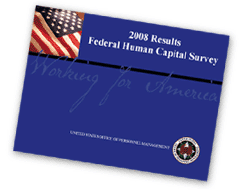 TSA employees responding to the 2008 Federal Human Capital Survey said the agency has improved in 91 percent of the areas covered - or 67 of 74 - since the last survey was done in 2006.
TSA employees responding to the 2008 Federal Human Capital Survey said the agency has improved in 91 percent of the areas covered - or 67 of 74 - since the last survey was done in 2006.
Improvements at TSA contributed to the Department of Homeland Security ranking among the five most improved agencies in the federal government, as measured by the survey. The Office of Personnel Management conducted the government-wide survey and employees were chosen randomly to participate.
At TSA, survey results pointed to positive gains in areas ranging from recognizing high performers to rewarding innovation, from leadership to employees having a feeling of personal empowerment.
On the broad question of overall job satisfaction, 58 percent of respondents gave TSA a favorable rating, up a substantial 18 percent from just two years earlier. Pay for performance scored higher at TSA than at either the DHS or the average for the entire federal government.
The survey results, which included 11 demographic questions in addition to the 74 substantive questions, also highlight challenges that are similar to those facing employees across DHS. Senior leaders emphasize that TSA is committed to addressing challenges, specifically those concerning the perception that promotions are too often without merit and that management fails to deal with poor performers.
Programs like the IdeaFactory, Security Evolution and TSA blogs, as well as the direct dialogue provided by the National Advisory Council, all offer the engaged TSA workforce opportunities to voice their concerns, offer innovations, or provide suggestions to improve performance.
"We are committed to our ongoing efforts with our employees to identify specific areas in need of improvement, and to make those improvements," said Acting Administrator Gale Rossides. "These survey results prove two things: TSA has some of the most dedicated people in the U.S. government and with 91 percent of all areas improving, our efforts to engage our employees, at all levels, are bringing positive results."
TSA's complete survey results are available on iShare.

TSA Phoenix Pilots Evolution Support Team
Sustainment Efforts Reinforced Across the Nation
By Ebony Burks, Evolution Support Team
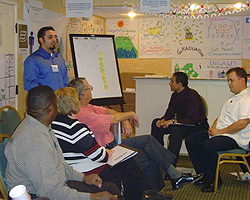
Phoenix Supervisory TSO Rick Diaz makes a presentation at a COACH! class. Photo by Janet Murphy
On Feb. 2-4, TSA Phoenix International Airport welcomed an Evolution Support Team (EST) to conduct a pilot as part of the agency's overall sustainment effort. The teams — made up of TSA's nearly 1,000 nationwide ENGAGE! and COACH! facilitators — assist local TSA offices with the promotion of Security Evolution principles in the areas of training, implementation and sustainment.
During the pilot, in order to encourage the exchange of information and gather best practices that can be applied elsewhere, EST members had opportunities to "engage" with the FSD staff, TSA management, training department personnel and officers.
In addition, EST members observe ENGAGE! and COACH! classes to ensure facilitators are in an environment that helps ensure the best learning experience. As the teams travel between airports, they identify trends and best practices that will be shared in roundtables and other discussions.
"Phoenix International Airport displays many of the ENGAGE! principles," said EST member Dwayne Surney, a supervisory TSO at Chicago's Midway International Airport. "For instance, create calm. Rather than yelling 'bag check' or 'female assist,' officers raise their hand and wait for acknowledgement to start secondary screening. Officers seem to easily grasp the Evolution concepts."
Additional EST visits to other airports are expected in the coming months.
With reporting from the Evolution Support Center in Arlington, Va.
Evolution: In the FSD's Own Words
Engage has empowered our workforce to utilize their knowledge and expertise to think critically and execute solutions to a variety of unexpected scenarios that can and often arise at a CAT X airport such as Newark. We look forward to implementing long-term measures to sustain the valuable skills learned in ENGAGE! and COACH!. — Deputy FSD Russell McCaffery, Newark (N.J.) Liberty International Airport
More News
Man Arrested at Checkpoint on Credit Card, Fraud Charges
By Gloria Campbell, customer service and quality improvement manager, Southwest Florida International Airport, Fort Myers
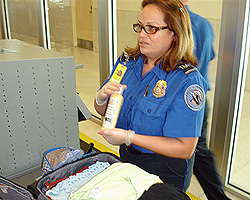
TSO Jael Escobar. Photo by Ken Green
Southwest Florida TSOs Jael Escobar and Tommy Alcock were recently recognized for "keen instinct and swift action" when they discovered a passenger was allegedly attempting to transport fraudulent credit cards and fake driver's licenses through the checkpoint.
When Alcock called for a search of the passenger's bin, Escobar began inspecting the items and noticed two wallets — one of which contained large stacks of credit cards with a name that did not match the man's boarding pass. She alerted Supervisory TSO Chris Coe, who discovered a driver's license with yet another name.
Coe called airport police. Anthony Elcorno Martin, of Highmount, N.Y., was arrested and charged with 35 counts of possessing counterfeit credit cards; three counts of illegal use of credit cards; one count of grand larceny; and two counts of possessing fraudulent driver's licenses. Airport police confirmed that an $11,000 diamond ring was purchased using one of the fraudulent credit cards.
"The training our officers receive prepares them for these types of incidents," said FSD Gerry Phelan. "TSO Escobar's situational awareness and the teamwork among the involved officers is testament to the professionalism and vigilance that passengers encounter at checkpoints across the country."
TSA Expands Homeland Security Course
By William Bartanowicz, training coordinator, San Antonio International Airport
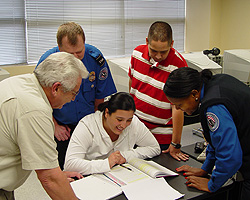
From left, Instructor J. D. Richardson, TSOs Gary Lords, Jessica Garcia and Antonio Talamantez, and Expert Behavior Detection Officer Miranda Madison. Photo by Lynda Johnson
TSA has expanded the pilot of the Homeland Security Associate Degree Program to San Antonio, where study topics for officers include politics, law, critical infrastructure, weapons of mass destruction, cyber threats, media and intelligence and emergency response.
Joining the officers on Jan. 26 to kick off San Antonio's first class, Introduction to Homeland Security, was Gina Nightengale, deputy chief learning officer, and Tom Dunmire, senior national program manager, both from the Office of Human Capital. Nightengale recently joined TSA from the Department of Health and Human Services where she had been the director of that agency's university.
The 16-week course, held at San Antonio College, is free for officers. As part of the program, the other class offered is Interpersonal Communication. After completing the courses, officers can apply the credits toward either a TSA Homeland Security Certificate and/or an associate degree in Homeland Security.
Nightengale addressed the importance of TSA providing officers continuing education opportunities for professional development and answered questions from the class participants.
One student, San Antonio TSO Antonio Talamantez, said the course "empowers officers with a solid foundation of knowledge that includes a short history about why TSA was created and our role in securing the nation's airports from future terrorist attacks."
The courses are also offered at Anne Arundel and Northern Virginia community colleges for TSOs at Baltimore/Washington International Thurgood Marshall and Ronald Reagan Washington National airports. If the pilot is successful, TSA will expand to an associate degree and develop a national curriculum.
"The Interpersonal Communication class helps improve communication across the workforce and teaches how to bring feelings out if an employee experiences a problem with a supervisor or lead," said Mark Balbuena, customer service liaison, Reagan National. "The class benefits not only those who are introverts, but the extroverts too."
If you have questions about the program, and work at any of the three pilot airports, please contact your training manager.
With reporting from Jonella Culmer, Office of Strategic Communications/Public Affairs
Southern California BAOs Deliver Realistic Training
By Nico Melendez, Office of Strategic Communications/Public Affairs
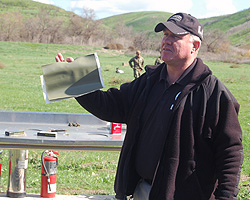
Los Angeles Bomb Appraisal Officer Wayne Grakowsky holds a Deta Sheet during a demonstration. Photo by Nico Melendez
Hollywood filmmakers have long used explosives to create great effects on the big screen. Such an explosion — up close and personal — makes clear what TSA officers potentially face every day as they screen passengers and checked baggage for explosives or their component parts.
Bomb Appraisal Officer (BAO) Larry Goshen, Los Angeles International Airport, along with his counterparts at John Wayne, Burbank, Ontario and Long Beach airports, recently made that type of training a reality.
The BAOs, working with explosives ordnance disposal teams from California's Marine Corps Base Camp Pendleton, provided five, one-day classes of training for about 375 TSOs from area airports.
"This training brings reality to something we look for every day," said Lead TSO Christopher Coty, Los Angeles. "This is something we need to see more often."
Goshen, a retired Marine, considers the training a necessary tool. "You have to ask yourself, do these TSOs truly understand the impact of an explosive?" he asked. "Very few people ever see an actual explosive detonate, so it seems like common sense to show them the effects of something they are looking to find."
During five hours of training, TSOs toured the Camp Pendleton explosives museum, then rode by bus to a nearby range for a demonstration involving bomb components and agents like blasting caps, dynamite, TNT, Det Cord, Deta Sheet, Anfo and nitromethane. For added reality, the Deta Sheet is attached to the shell of a laptop computer and other explosives are placed in shoes and small liquid containers.
TSO Jeff Marshal of Los Angeles said the demonstration gave him pause. "After seeing these explosions, I may take a few more moments and pay special attention to that block of cheese."
"For those with no military background this really brings it home," added Supervisory TSO John Justice, Los Angeles.
Boise Welcomes Special Olympic World Winter Games
By Dwayne Baird, Office of Strategic Communications/Public Affairs
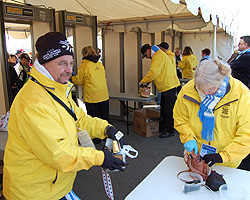
TSOs Robert Hanson and Jane Rossenbach, both from Boise, search bags. Photo by Dwayne Baird
Idaho state TSOs volunteered to screen more than 8,000 spectators at the opening ceremonies of the 2009 International Special Olympic World Winter Games at the Idaho Center in Nampa on Feb. 7.
Behavior detection officers from Boise, Idaho and federal air marshals from Seattle and Houston assisted with security before and during the event. Visible Intermodal Prevention and Response (VIPR) teams along with national deployment officers assisted with surface as well as aviation security.
Idaho FSD Andy Coose described the scene as "screening at high speed and efficiency at its peak … You should have seen our TSA volunteers in action."
The spectators came from around the world and spoke many different languages, adding to the challenge. Most of the 3,000 athletes were screened at another entrance of the center, after coming through the Boise and Salt Lake City airports.
Kudos & Clips
TSA's New Secret Weapon: Politeness
Goal of Airport Security Training Course is More Engaged Workers
By Harriet Baskas, MSNBC.com, Feb. 12, 2009
Don't be surprised or alarmed if the next time you go through the security checkpoint at the airport you find TSA staff handing out smiles and warm greetings instead of barked orders, mean looks and stern commands. There may even be some TSA-approved hugging and high-fiving going on back there behind the X-ray machines. Read more.
Our group of six, including three children, were flying ... out of Buffalo (N.Y.) to Ontario, Calif. ... When we were going through security we were lucky enough to pass through [with help from] TSO Gladys Turner. She was completely thorough and professional while checking our passports and made the process interesting for the children as she showed them the security features on their passports. She was friendly and smiled as she spoke with each of us. Even the children remarked about how nice and polite she was.
Nicole McLaughlin, Buffalo, N.Y, to Jeffrey Kline, deputy assistant federal security director - screening, Buffalo Niagara International Airport. Feb. 11, 2009.
I'm a frequent flyer and travel frequently on the West Coast, including Alaska. I have to say that Supervisory TSO Helen Morin's team at John Wayne Airport (Santa Ana, Calif.) was absolutely the best crew I have come across. They were the most friendly and service-oriented group I have seen. I was traveling with my family and they pointed out the family-friendly lane; the agent gave stickers to the children; and had conversation with my 5-year-old granddaughter. The officers at the X-ray area were also very friendly.
Scott McCulloch, Anchorage, Alaska, to Cheryl Paine, stakeholder and customer support and quality improvement manager, John Wayne Airport. Feb. 8, 2009.
The TSA Experience
Uniform Donation Supports Needy Children

Pictured are (from left) Supervisory TSO Steve Mathiason; TSO Renee Wegener; Trudy Novak, Linus Project; and TSOs Kathy Larson and Tara Bair. Photo by Krysta Bachman
After removing the patches and donating old TSA uniforms to the non-profit program "Project Linus," officers at Oregon's Klamath Falls and Rogue Valley International-Medford airports were thanked with a customized quilt that read "TSA" on two corners. Project Linus is made up of volunteers who make quilts for distribution to seriously ill children. The old uniforms are used as material for the quilts. The officers said they were "honored and privileged" to contribute.
BDO Thanks TSA Buffalo for Support During Deployment

Photo by Carl Nocera
U.S. Army Staff Sgt. David M. DiTullio (left), an expert behavior detection officer at Buffalo Niagara (N.Y.) International Airport, presents Federal Security Director Derek (Rick) DiPietro a U.S. flag that recently flew over U.S. Firebase Maholic in Kandahar Province, Afghanistan. DiTullio presented the flag in recognition of the support he received from the TSA Buffalo workforce during his recent active duty deployment in Afghanistan. During the ceremony, DiTullio spoke about the pride he feels for the opportunity to serve with both his fellow soldiers and TSA co-workers. At both TSA and in the military, he said his goal is to work with team members to eliminate significant threats.
E-mail your comments and suggestions.



